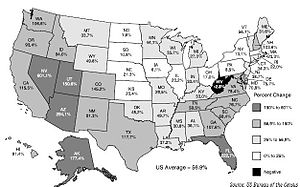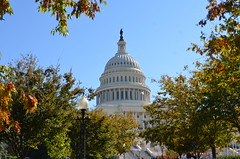Then there is the chance to visit with family. The stresses of modern life make family more important than ever. I am lucky to have a great family that loves me. The top of the list of many things I have to be thankful for on this day of thanks.
Here are some fun facts related to Thanksgiving from our friends over at the census bureau:
4
Number of places in the United States named after the holiday’s traditional main course. Turkey Creek, La., was the most populous in 2012, with 440 residents, followed by Turkey, Texas (415), Turkey, N.C. (295) and Turkey Creek, Ariz. (294). There are also two townships in Pennsylvania with “Turkey” in the name: Upper Turkeyfoot and Lower Turkeyfoot. (Please note that the Turkey Creek, Ariz., population total pertains to the 2010 Census).
Source:
U.S. Census Bureau, 2012 Population Estimates and American FactFinder, Table DP-1, 2010 Census Summary File 1
>
>
7
Number of places and townships in the United States that are named Cranberry or some spelling variation of the acidic red berry (e.g., Cranbury, N.J.), a popular side dish at Thanksgiving. Cranberry Township (Butler County), Pa., was the most populous of these places in 2012, with 28,832 residents. Cranberry township (Venango County), Pa., was next (6,608). (Please note that population totals for the two places on the list that are census designated places ─ Cranbury, N.J., with a population of 2,181, and Cranberry Lake, N.Y., with a population of 200 ─ pertain to 2010.)
> <
http://factfinder2.census.gov/faces/tableservices/jsf/pages/productview.xhtml?fpt=table
>
32
Number of counties, places and townships in the United States named Plymouth, as in Plymouth Rock, the landing site of the first Pilgrims. The two counties, both named Plymouth, are in Massachusetts (2012 population of 499,759) and Iowa (24,907 in 2012).
Plymouth, Minn., is the most populous place, with 72,928 residents in 2012; Plymouth, Mass., had 57,463 that year.
There are two places in the United States named Pilgrim: One, a township in Dade County, Mo., had a 2012 population of 127; the other, a census designated place in Michigan, had a 2010 population of 11.And then there is Mayflower, Ark., whose population was 2,312 in 2012, and Mayflower Village, Calif., whose population was 5,515 in 2010.
Note: Townships have been included in these counts from 12 states (Connecticut, Maine, Massachusetts, Michigan, Minnesota, New Hampshire, New Jersey, New York, Pennsylvania, Rhode Island, Vermont and Wisconsin) where the primary governmental or administrative divisions of a county serve as general-purpose local governments that can perform the same governmental functions as incorporated places. These county subdivisons are known as minor civil divisions, and the Census Bureau presents data for these in all data products for which place data are provided.
>
>
>
2012 Population Estimates
>
>
Participants in the First Feast
25.3 million
Number of U.S. residents of English ancestry as of 2012. Some could very well be descendants of the Plymouth colonists who participated in the autumn feast that is widely believed to be one of the first Thanksgivings ─ especially the 684,000 living in Massachusetts. Source: 2012 American Community Survey, Table
B04003
.
6,500
Number of members of the Wampanoag American Indian tribal grouping, as of 2010, roughly half of whom reside in Massachusetts. The Wampanoag, the American Indians in attendance, played a lead role in this historic encounter, and they had been essential to the survival of the colonists during the newcomers’ first year. The Wampanoag are a people with a sophisticated society who have occupied the region for thousands of years. They have their own government, their own religious and philosophical beliefs, their own knowledge system, and their own culture. They are also a people for whom giving thanks was a part of daily life.
>; and
>.
Preparing the Feast … Enjoying the Day … and the Aftermath
98.6%
Percentage of households in 2011 with a gas or electric stove ─ essential for cooking their Thanksgiving feast. Another 96.8 percent had a microwave, also helpful in preparing the meal.
>
98.3%
Percentage of households with a television in 2011. No doubt, many guests either before, after, or perhaps even during the feast will settle in front of their TVs to watch some football.
>
35.8%
Percentage of households with a stand-alone food freezer in 2011, which they may want to use to preserve their Thanksgiving leftovers. Far more (99.2 percent) have a refrigerator. Once all the guests leave, it will be time to clean up. Fortunately, 69.3 percent have a dishwasher to make the task easier.
>
Culinary Delights
64,366
The number of supermarkets and other grocery (except convenience) stores in the United States in 2011. These establishments are expected to be extremely busy around Thanksgiving, as people prepare for their delightful meals. Source: U.S. Census Bureau, County Business Patterns, NAICS Code 44511<
http://www.census.gov/econ/cbp/
>
3,889
The number of baked goods stores in the United States in 2011 – a potential place to visit to purchase refreshing desserts. Source: U.S. Census Bureau, County Business Patterns, NAICS Code 445291<
http://www.census.gov/econ/cbp/
>
2,918
The number of fruit and vegetable markets in the United States in 2011 – a great place to find holiday side dishes.
Source: U.S. Census Bureau, County Business Patterns, NAICS Code 445230
>
242 million
The number of turkeys forecasted to be raised in the United States in 2013. That is down 5 percent from the number raised during 2012.
>
45 million
The forecast for the number of turkeys Minnesota will raise in 2013. The Gopher State was tops in turkey production, followed by North Carolina (35 million), Arkansas (29 million), Indiana (17 million), Missouri (17 million), and Virginia (16 million).
>
$23.1 million
The value of U.S. imports of live turkeys for 2012, with 99.8 percent of them coming from Canada. When it comes to sweet potatoes, the Dominican Republic was the source of 51.1 percent ($4.6 million) of total imports ($9.1 million). The United States ran a $17.6 million trade deficit in live turkeys during the period but had a surplus of $71.2 million in sweet potatoes.
Source: U.S. Census Bureau, Foreign Trade Statistics
/>
768 million pounds
The forecast for U.S. cranberry production in 2012. Wisconsin was estimated to lead all states in the production of cranberries, with 450 million pounds, followed by Massachusetts (estimated at 210 million).
New Jersey, Oregon and Washington were also estimated to have substantial production, ranging from 14 to 54 million pounds.
Source: USDA National Agricultural Statistics Service,
>
2.6 billion pounds
The total weight of sweet potatoes — another popular Thanksgiving side dish — produced by major sweet potato producing states in 2012. North Carolina (1.2 billion pounds) produced more sweet potatoes than any other state, followed by California, Mississippi and Louisiana.
>






































